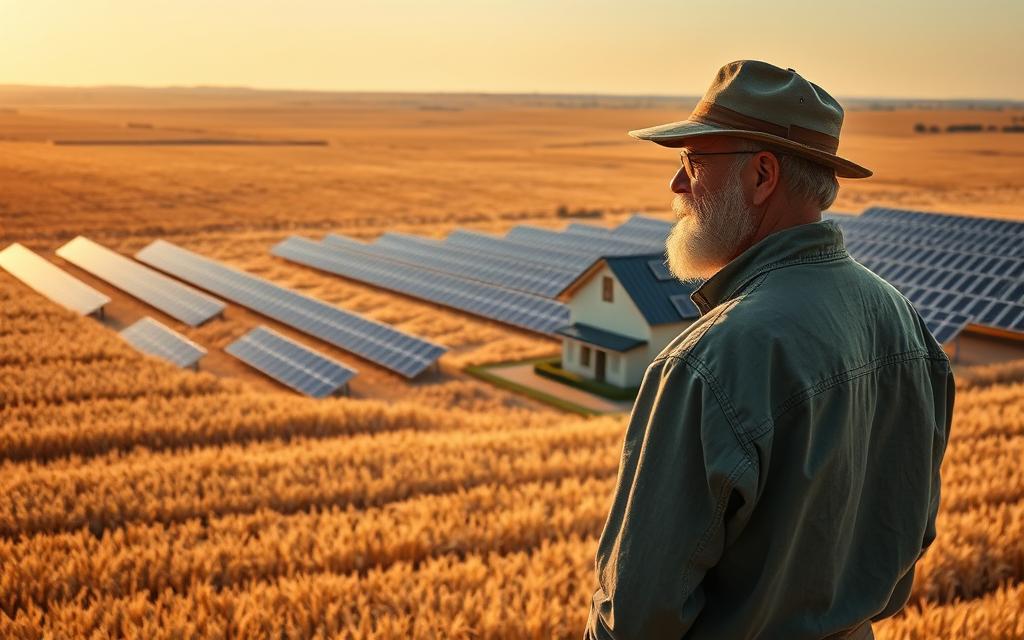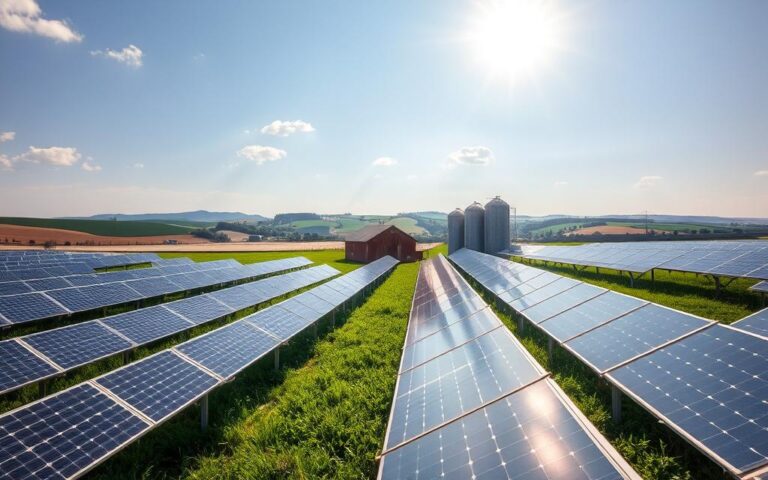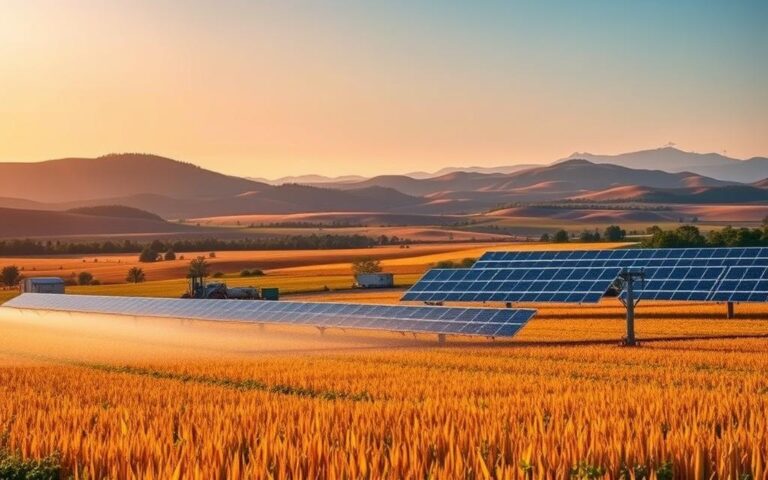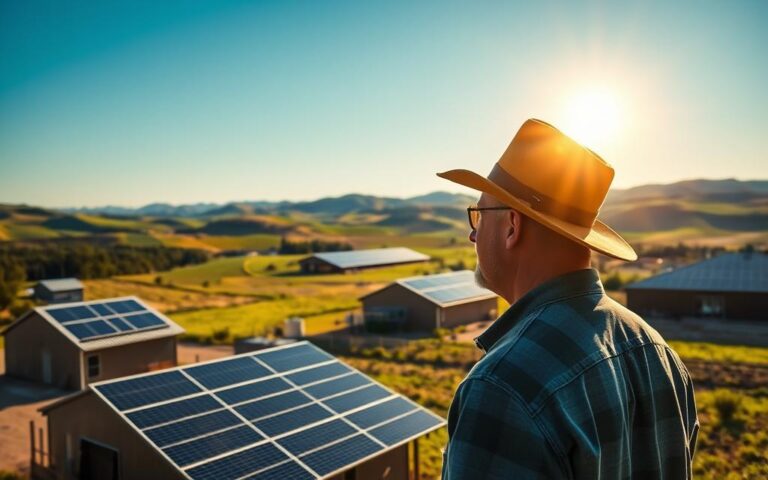Did you know over 20% of U.S. farms now use solar power? This big change is happening because of money, the planet, and rules. Solar energy is becoming a key part of farming, helping farmers be more independent and fight climate change.
As more people want clean energy, farms turning to solar help meet this need. This move also keeps farming strong for the future.
The Growing Trend of Solar Energy on U.S. Farms
Solar energy is growing fast in U.S. farms. Farms are leading the way with more solar power. From 2022 to 2023, solar installations jumped by over 51%.
This growth makes up about 54% of the country’s new power. It shows how big a role farms play in using renewable energy.
The U.S. solar energy production is growing at 25% each year. Farms are choosing solar for its benefits. This choice has made solar cheaper by over 40%.
By June 2024, the U.S. had installed about 200 gigawatts of solar power. This helps millions of homes and supports a lot of new power generation.
Understanding Solar Power in American Agriculture
Solar power has changed farming in America. Farmers use it to save energy and boost their work. Over 83% of new solar projects will be on farms. This shows solar’s big impact on farming, as more farms use it.
Impact of Solar Growth on Farm Operations
More farms using solar energy means big benefits. They save on energy costs and use less traditional energy. This makes farms more resilient and helps the environment.
Farms are choosing solar for economic and green reasons. They want to cut down on carbon and be more sustainable.
Statistics on Solar Energy Adoption in Agriculture
New data shows solar’s growing role in farming. Solar could go from 4% to 45% of energy by 2050. This means farms will need about 10.4 million acres for solar.
This shows the challenge farmers face. They need to balance energy production with keeping land fertile.
Benefits of Solar Energy for Farmers
Using solar energy in farming has many benefits. It saves money and makes farmers more independent. Solar power changes how farmers make money and gives them stable energy.
Cost Savings and Financial Incentives
Switching to solar energy saves farmers a lot of money. It cuts down on utility bills, making more profit. Governments also offer financial help through tax credits and grants.
These programs help lower the cost of starting a solar project. Many farmers get offers to lease land for solar farms, earning more than usual. This helps farmers make more money and move towards green energy.
Energy Independence and Stability
Solar energy helps farmers be less dependent on fossil fuels. It makes energy prices more stable. Solar technology lets farmers control their energy better.
This change helps farmers keep working smoothly, no matter what the market does. Solar energy makes farming more sustainable and helps it grow.
Environmental Impact of Solar Energy in Agriculture
Using solar energy in farming brings big environmental wins. It helps farms use energy better and work towards being more sustainable. Solar power helps farms cut down on carbon emissions and improve their land’s health.
Reducing Carbon Footprint
Solar energy is a key tool for farmers wanting to lower emissions. By using solar power, farms use less fossil fuels. This makes the ecosystem cleaner and helps reduce greenhouse gases.
Sustainable Land Use Practices
It’s important for farms to use land wisely for the future. Solar panels can work alongside farming through agrivoltaics. This way, land is used for crops and solar power, making farming more efficient and eco-friendly.
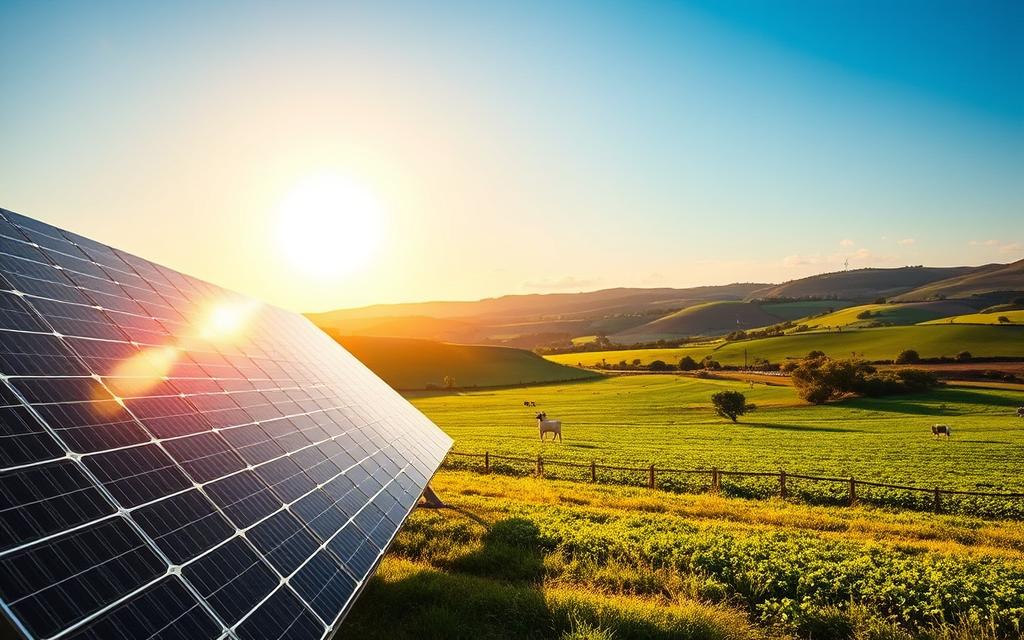
Factors Driving the Shift to Solar Energy
Farms are turning to solar energy for many reasons. The cost of solar installations has gone down a lot. Also, government incentives for solar are helping a lot. These changes are making solar power more appealing to farmers.
Declining Installation Costs
In the last ten years, solar installation costs have dropped by 40%. This makes solar energy more affordable for farmers. They can now invest in solar systems without breaking the bank. This is good for their wallets and the planet.
Government Policies and Incentives
Government support for solar energy is also a big help. Programs like the Inflation Reduction Act offer tax credits and grants. These incentives make it easier for farmers to switch to solar energy.
| Year | Average Solar Installation Cost ($/Watt) | Government Incentives Available |
|---|---|---|
| 2013 | 4.50 | 25% Tax Credit |
| 2018 | 3.00 | 30% Tax Credit + Grants |
| 2023 | 2.70 | 30% Tax Credit + State Programs |
With lower solar costs and more government help, farming is changing. These changes improve energy use and help farms last longer. It’s a win-win for the environment and farmers.
Solar Power Solutions for Agriculture
Farmers are now using solar power to make their farms more efficient and green. They choose solar rooftops and ground-mounted arrays to cut down on energy costs. This move is becoming more popular as it helps the environment and saves money.
Solar power lets farmers use their land in two ways. They can grow crops and collect solar energy at the same time. This approach helps farmers earn more money and supports sustainable farming.
Using solar energy makes farms more independent and helps the planet. It lets farmers play a big role in making clean energy. Many farmers see how solar power boosts their farm’s productivity and helps the environment.
Agricultural Solar Panels: Types and Technologies
Farmers are now using different solar panels to get more energy from the sun. Choosing the right solar panels can really help with costs. Knowing about the various solar panels and new trends helps farmers make smart choices.
Different Types of Solar Panels for Farms
There are many solar panels for farms. Here are a few:
- Traditional Photovoltaic (PV) Panels: These panels turn sunlight into electricity and are used a lot.
- Bifacial Panels: These panels catch sunlight from both sides, making them more efficient.
- Concentrated Solar Power Systems: This tech uses mirrors or lenses to focus sunlight, making heat that turns into electricity.
Emerging Solar Technology Trends
New solar tech is bringing fresh ideas to farming. Some trends include:
- Agrifoltaics: This method lets farms grow food and make energy at the same time, using land better and helping the environment.
- Smart Solar Solutions: Using IoT and smart grids makes monitoring and using energy better, helping farmers make informed choices.
- Energy Storage Systems: These systems keep energy for when it’s needed, making sure farms always have power.
The future of solar energy in farming is bright. New solar panels and tech trends are making a big difference. Working with tech partners is key to using solar energy well, helping farmers get the most from their solar investments.
Integrating Solar Energy with Traditional Farming Practices
Agrivoltaics is a new way to make farming sustainable and use solar energy. It lets farmers use their land for both growing crops and making energy. This method makes land use more efficient and helps farming in many ways.
Agrivoltaics: Co-location of Solar and Crop Production
Agrivoltaics changes how we think about energy and farming. Farmers can grow crops under and around solar panels. This setup can make crops grow better because it uses less water.
It also helps the local environment by creating homes for animals and plants. So, using solar and farming together is good for the planet and farmers’ pockets.
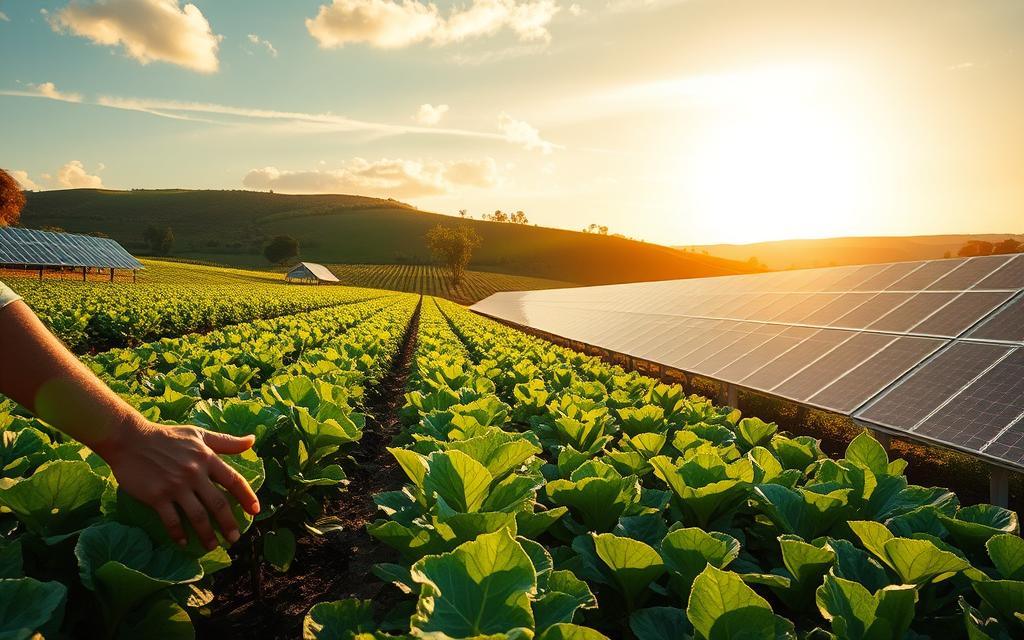
Challenges in Implementing Solar Energy on Farms
Switching to solar energy on farms comes with big challenges. Local communities worry about land use conflicts. They question how to balance farming and energy production.
Farms, once for crops and animals, face pushback for solar farms. This can hurt farmers’ plans to go solar.
Land Use Conflicts and Public Backlash
Solar farms lead to land use conflicts. Rural areas, focused on farming, struggle with solar projects. This sparks debates over environmental effects and landscape changes.
Farmers are caught in the middle. They need sustainable energy but face community opposition to solar.
Infrastructure and Interconnection Issues
Infrastructure problems add to the challenges. Many areas lack the grid connections needed for solar farms. This leads to delays and uncertainty for farmers.
These issues make it hard for farmers to use solar energy. It affects their energy supply and income.
| Challenge | Description |
|---|---|
| Land Use Conflicts | Disputes arise when agricultural land is converted for solar use, often leading to community opposition. |
| Public Backlash | Local residents may resist large-scale solar projects, fearing environmental impacts and changes to rural landscapes. |
| Infrastructure Issues | Inadequate transmission infrastructure complicates the connection of solar farms to the electrical grid. |
| Interconnection Delays | Long wait times for grid interconnection can disrupt farmers’ project timelines, affecting energy reliability. |
The Future of Solar Energy in American Agriculture
The world of solar energy in American farming is changing fast. As more people want clean energy, solar in farming looks very promising. Using solar power in farming helps the planet and gives farmers new chances to grow.
Long-term Projections and Growth Opportunities
By 2050, solar energy might make up to 45% of U.S. energy. A lot of this energy will come from farms. Farmers will gain by being more energy independent and having more ways to make money.
Switching to solar energy can also lower costs for farmers. It helps them reach bigger goals for sustainability.
| Year | % of U.S. Energy from Solar | Growth Opportunities in Solar |
|---|---|---|
| 2025 | 20% | Increased installation of solar panels on farms |
| 2030 | 30% | Expansion of agrivoltaic systems |
| 2040 | 40% | Collaborations between farmers and energy companies |
| 2050 | 45% | Investment in solar technology research and innovations |
Farmers who jump into solar energy early will benefit a lot. They need to find a good mix between making energy and farming well. This will help them get the most out of solar energy.
Conclusion
The shift to solar energy in American farming is key for a sustainable future. More farmers are using solar power, making their work more efficient and helping the planet. Solar energy saves costs, makes farms energy-independent, and cuts down on carbon emissions.
But, there are hurdles to overcome. It’s important to balance solar use with farming needs. This ensures farmland remains productive while using green energy. Farmers, policymakers, and experts must work together to make this happen.
The outlook for solar energy in farming is bright. New tech, government support, and a focus on sustainability are helping. This teamwork will improve farm economies and create a greener future for farming.

